Compounded Impacts of Global Warming and Anthropogenic Disturbances on Snowmelt in Northern Baffin Island
Abstract
1. Introduction
2. Materials and Methods
2.1. Study Area
2.2. Data
2.3. Methodology
3. Results
3.1. Dust Plume Observed from WV Data
3.2. Dust Extent Derived from Sentinel-2 Image
3.3. Changes in Snow Cover Based on the Whole Study Region
3.4. Pixel-Wise Analysis of Snowmelt Trend
3.5. Snow Cover Changes in Response to Global Warming and the Mine Activities
4. Discussion
5. Conclusions
- (1)
- Fugitive dust originated from the crushing processing, transportation, and stockpiles and the dustfall is regularly monitored by dust samples. How far the dust can be transported and what threshold should be of concern, is of debate. Using snow discoloration as an indicator, we found that the dust plume extended beyond the ranges of the reference sites for dust samples, from where the dustfall is below the detection threshold in the summer. The difference between remote sensing detection in the winter and ground measurements in the summer is worthy of more investigation.
- (2)
- Early snowmelt trends in this study region have existed prior to the Mine’s operation, with Arctic warming as the most likely driver. The early snowmelt trend occurred mostly in lowland areas; the early snowmelt in this study region is in line with the similar changes found in other Pan-Arctic areas.
- (3)
- The Mine’s operation is correlated with strong and localized early snowmelt trends, and the impacted area has been increasing in the last few years, especially in the winter season. Fugitive dust has been reported around the Milne Inlet port, e.g., on sea ice and the tote road, and future studies could evaluate the relationship between fugitive dust and soot from mining activities and the noted earlier snowmelt. The early snowmelt areas are indicated in a zone up to two kilometers away from the road.
Supplementary Materials
Author Contributions
Funding
Data Availability Statement
Acknowledgments
Conflicts of Interest
References
- Nunatsiaq News. Available online: https://nunatsiaq.com/stories/article/baffinland-exceeded-dust-impact-projections-for-3-straight-years-qia/ (accessed on 9 December 2022).
- Mioduszewski, J.R.; Rennermalm, A.K.; Robinson, D.A.; Mote, T.L. Attribution of snowmelt onset in Northern Canada. J. Geophys. Res. Atmos. 2014, 119, 9638–9653. [Google Scholar] [CrossRef]
- Skiles, S.M.K.; Flanner, M.; Cook, J.M.; Dumont, M.; Painter, T.H. Radiative forcing by light-absorbing particles in snow. Nat. Clim. Change 2018, 8, 964–971. [Google Scholar] [CrossRef]
- Di Mauro, B.; Fugazza, D. Pan-Alpine glacier phenology reveals lowering albedo and increase in ablation season length. Remote Sens. Environ. 2022, 279, 113119. [Google Scholar] [CrossRef]
- Di Mauro, B. A darker cryosphere in a warming world. Nat. Clim. Change 2020, 10, 979–980. [Google Scholar] [CrossRef]
- Sarangi, C.; Qian, Y.; Rittger, K.; Ruby Leung, L.; Chand, D.; Bormann, K.J.; Painter, T.H. Dust dominates high-altitude snow darkening and melt over high-mountain Asia. Nat. Clim. Change 2020, 10, 1045–1051. [Google Scholar] [CrossRef]
- Oerlemans, J.; Giesen, R.H.; Van Den Broeke, M.R. Retreating alpine glaciers: Increased melt rates due to accumulation of dust (Vadret da Morteratsch, Switzerland). J. Glaciol. 2009, 55, 729–736. [Google Scholar] [CrossRef]
- Réveillet, M.; Dumont, M.; Gascoin, S.; Lafaysse, M.; Nabat, P.; Ribes, A.; Nheili, R.; Tuzet, F.; Ménégoz, M.; Morin, S.; et al. Black carbon and dust alter the response of mountain snow cover under climate change. Nat. Commun. 2022, 13, 5279. [Google Scholar] [CrossRef]
- Flanner, M.G.; Zender, C.S.; Randerson, J.T.; Rasch, P.J. Present-day climate forcing and response from black carbon in snow. J. Geophys. Res. Atmos. 2007, 112, D11202. [Google Scholar] [CrossRef]
- Painter, T.H.; Skiles, S.M.; Deems, J.S.; Brandt, W.T.; Dozier, J. Variation in Rising Limb of Colorado River Snowmelt Runoff Hydrograph Controlled by Dust Radiative Forcing in Snow. Geophys. Res. Lett. 2018, 45, 797–808. [Google Scholar] [CrossRef]
- Frei, A.; Tedesco, M.; Lee, S.; Foster, J.; Hall, D.K.; Kelly, R.; Robinson, D.A. A review of global satellite-derived snow products. Adv. Space Res. 2012, 50, 1007–1029. [Google Scholar] [CrossRef]
- Wang, L.; Derksen, C.; Brown, R.; Markus, T. Recent changes in pan-Arctic melt onset from satellite passive microwave measurements. Geophys. Res. Lett. 2013, 40, 522–528. [Google Scholar] [CrossRef]
- Derksen, C.; Brown, R. Spring snow cover extent reductions in the 2008–2012 period exceeding climate model projections. Geophys. Res. Lett. 2012, 39, 19504. [Google Scholar] [CrossRef]
- Trishchenko, A.P.; Leblanc, S.G.; Wang, S.; Li, J.; Ungureanu, C.; Luo, Y.; Khlopenkov, K.V.; Fontana, F. Variations of Annual Minimum Snow and Ice Extent over Canada and Neighboring Landmass Derived from MODIS 250-m Imagery for 2000–2014. Can. J. Remote Sens. 2016, 42, 214–242. [Google Scholar] [CrossRef]
- Rizzi, J.; Nilsen, I.B.; Stagge, J.H.; Gisnås, K.; Tallaksen, L.M. Five decades of warming: Impacts on snow cover in Norway. Hydrol. Res. 2018, 49, 670–688. [Google Scholar] [CrossRef]
- Callaghan, T.V.; Johansson, M.; Brown, R.D.; Groisman, P.Y.; Labba, N.; Radionov, V.; Barry, R.G.; Bulygina, O.N.; Essery, R.L.H.; Frolov, D.M.; et al. The Changing Face of Arctic Snow Cover: A Synthesis of Observed and Projected Changes. AMBIO 2011, 40, 17–31. [Google Scholar] [CrossRef]
- Thiebault, K.; Young, S. Snow cover change and its relationship with land surface temperature and vegetation in northeastern North America from 2000 to 2017. Int. J. Remote Sens. 2020, 41, 8453–8474. [Google Scholar] [CrossRef]
- Jan, A.; Painter, S.L. Permafrost thermal conditions are sensitive to shifts in snow timing. Environ. Res. Lett. 2020, 15, 084026. [Google Scholar] [CrossRef]
- Stone, R.S.; Dutton, E.G.; Harris, J.M.; Longenecker, D. Earlier spring snowmelt in northern Alaska as an indicator of climate change. J. Geophys. Res. Atmos. 2002, 107, ACL 10-1–ACL 10-13. [Google Scholar] [CrossRef]
- Niittynen, P.; Heikkinen, R.K.; Luoto, M. Snow cover is a neglected driver of Arctic biodiversity loss. Nat. Clim. Change 2018, 8, 997–1001. [Google Scholar] [CrossRef]
- Happonen, K.; Aalto, J.; Kemppinen, J.; Niittynen, P.; Virkkala, A.M.; Luoto, M. Snow is an important control of plant community functional composition in oroarctic tundra. Oecologia 2019, 191, 601–608. [Google Scholar] [CrossRef]
- Mooney, E.; Mullins, M.; Den Uyl, J.; Trail, S.; Nguyen, P.; Owens, J.; Godtfredsen, E.; Heschel, S. Early snowmelt reduces aphid abundance (Aphis asclepiadis) by creating water-stressed host plants (Ligusticum porteri) and altering interactions with ants. Arthropod-Plant Interact. 2021, 15, 33–46. [Google Scholar] [CrossRef]
- Francon, L.; Corona, C.; Till-Bottraud, I.; Choler, P.; Carlson, B.Z.; Charrier, G.; Améglio, T.; Morin, S.; Eckert, N.; Roussel, E.; et al. Assessing the effects of earlier snow melt-out on alpine shrub growth: The sooner the better? Ecol. Indic. 2020, 115, 106455. [Google Scholar] [CrossRef]
- Melin, M.; Mehtätalo, L.; Helle, P.; Ikonen, K.; Packalen, T. Decline of the boreal willow grouse (Lagopus lagopus) has been accelerated by more frequent snow-free springs. Sci. Rep. 2020, 10, 6987. [Google Scholar] [CrossRef] [PubMed]
- Campbell, D.R. Early snowmelt projected to cause population decline in a subalpine plant. Proc. Natl. Acad. Sci. USA 2019, 116, 12901–12906. [Google Scholar] [CrossRef] [PubMed]
- Langlois, A.; Johnson, C.A.; Montpetit, B.; Royer, A.; Blukacz-Richards, E.A.; Neave, E.; Dolant, C.; Roy, A.; Arhonditsis, G.; Kim, D.K.; et al. Detection of rain-on-snow (ROS) events and ice layer formation using passive microwave radiometry: A context for Peary caribou habitat in the Canadian Arctic. Remote Sens. Environ. 2017, 189, 84–95. [Google Scholar] [CrossRef]
- CBC News Report. Available online: https://www.cbc.ca/news/canada/north/mystery-caribou-deaths-arctic-island-1.3962747 (accessed on 2 February 2017).
- Assmann, J.J.; Myers-Smith, I.H.; Phillimore, A.B.; Bjorkman, A.D.; Ennos, R.E.; Prevéy, J.S.; Henry, G.H.R.; Schmidt, N.M.; Hollister, R.D. Local snow melt and temperature—But not regional sea ice—Explain variation in spring phenology in coastal Arctic tundra. Glob. Chang. Biol. 2019, 25, 2258–2274. [Google Scholar] [CrossRef]
- John, C.; Miller, D.; Post, E. Regional variation in green-up timing along a caribou migratory corridor: Spatial associations with snowmelt and temperature. Arct. Antarct. Alp. Res. 2020, 52, 416–423. [Google Scholar] [CrossRef]
- Baffin Island. Available online: https://en.wikipedia.org/wiki/Baffin_Island (accessed on 29 December 2022).
- Mary River Mine. Available online: https://en.wikipedia.org/wiki/Mary_River_Mine (accessed on 29 December 2022).
- Mcgee, N. Indigenous Opposition to Arctic Mine Expansion Could Halt Development. Available online: https://www.theglobeandmail.com/business/article-baffinland-iron-ore-expansion-plans-in-arctic-raise-concerns-for-inuit/#:~:text=Indigenous%20opposition%20to%20Arctic%20mine%20expansion%20could%20halt%20development,-Niall%20McGee%20Mining&text=Mary%20River%20iron%20ore%20on%20Baffin%20Island%2C%20Nunavut.&text=Baffinland%20says%20the%20expansion%20is,on%20buoyant%20iron%20ore%20prices (accessed on 5 February 2022).
- Spring, R. Inuit Speak Out against Expansion of Arctic Iron Mine, Community Concerned over Wildlife Impacts. Available online: https://wwf.ca/stories/inuit-speak-out-against-expansion-of-arctic-iron-mine/ (accessed on 2 February 2022).
- Tigue, K. On Baffin Island in the Fragile Canadian Arctic, an Iron Ore Mine Spews Black Carbon. Available online: https://insideclimatenews.org/news/02042020/baffin-island-canada-arctic-iron-ore-mine-black-carbon/. (accessed on 8 December 2022).
- Hall, D.K.; Riggs, G.A. Accuracy assessment of the MODIS snow products. Hydrol. Process. 2007, 21, 1534–1547. [Google Scholar] [CrossRef]
- Hall, D.K.; Riggs, G.A. MODIS/Terra Snow Cover Daily L3 Global 500 m SIN Grid, Version 6; NASA National Snow and Ice Data Center Distributed Active Archive Center: Boulder, CO, USA, 2016. [Google Scholar] [CrossRef]
- Salomonson, V.V.; Appel, I. Estimating fractional snow cover from MODIS using the normalized difference snow index. Remote Sens. Environ. 2004, 89, 351–360. [Google Scholar] [CrossRef]
- Riggs, G.A.; Hall, D.K. MODIS Snow Products Collection 6 User Guide; 2016. Available online: https://modis-snow-ice.gsfc.nasa.gov/uploads/C6_MODIS_Snow_User_Guide.pdf (accessed on 1 December 2022).
- Riggs, G.A.; Hall, D.K.; Román, M.O. MODIS/Terra Snow Cover 8-Day L3 Global 500 m SIN Grid, Version 6. Available online: https://nsidc.org/data/MOD10A2/versions/6/print (accessed on 5 February 2022).
- Latifovic, R.; Pouliot, D.; Olthof, I. Circa 2010 Land Cover of Canada: Local Optimization Methodology and Product Development. Remote Sens. 2017, 9, 1098. [Google Scholar] [CrossRef]
- CDEM. Canadian Digital Elevation Model, 1945-2011; Natural Resources Canada: Ottawa, ON, Canada. Available online: https://open.canada.ca/data/en/dataset/7f245e4d-76c2-4caa-951a-45d1d2051333 (accessed on 1 December 2021).
- NLDAS-2. NLDAS-2: North American Land Data Assimilation System Forcing Fields; NASA/GSFC; NASA Goddard Earth Sciences Data and Information Services Center (GES DISC): Greenbelt, MD, USA, 2020. Available online: https://ldas.gsfc.nasa.gov/nldas/v2/forcing (accessed on 1 January 2021).
- Li, Z.; Erb, A.; Sun, Q.; Liu, Y.; Shuai, Y.; Wang, Z.; Boucher, P.; Schaaf, C. Preliminary assessment of 20-m surface albedo retrievals from sentinel-2A surface reflectance and MODIS/VIIRS surface anisotropy measures. Remote Sens. Environ. 2018, 217, 352–365. [Google Scholar] [CrossRef]
- Wang, F.; Shao, W.; Yu, H.; Kan, G.; He, X.; Zhang, D.; Ren, M.; Wang, G. Re-evaluation of the Power of the Mann-Kendall Test for Detecting Monotonic Trends in Hydrometeorological Time Series. Front. Earth Sci. 2020, 8, 14. [Google Scholar] [CrossRef]
- Fatichi, S. Mann-Kendall Test, MATLAB Central File Exchange. Available online: https://www.mathworks.com/matlabcentral/fileexchange/25531-mann-kendall-test (accessed on 29 December 2022).
- O’Leary Iii, D.; Hall, D.K.; Medler, M.; Matthews, R.; Flower, A. Snowmelt Timing Maps Derived from MODIS for North America, Version 2, 2001–2018; ORNL Distributed Active Archive Center: Oak Ridge, TN, USA, 2020. [Google Scholar] [CrossRef]
- Luomaranta, A.; Aalto, J.; Jylhä, K. Snow cover trends in Finland over 1961–2014 based on gridded snow depth observations. Int. J. Climatol. 2019, 39, 3147–3159. [Google Scholar] [CrossRef]
- Chen, W.; Leblanc, S.G.; White, H.P.; Prevost, C.; Milakovic, B.; Rock, C.; Sharam, G.; O’Keefe, H.; Corey, L.; Croft, B.; et al. Does Dust from Arctic Mines Affect Caribou Forage? J. Environ. Prot. 2017, 8, 258–276. [Google Scholar] [CrossRef]
- White, H.P.; Chen, W.; Leblanc, S.G.; Croft, B.; Adamczewski, J.; Patenaude, A.; Clark, K.; Pellissey, J.S.; Corey, L.; Hume, J.; et al. Satellite Observations for Detection of Dust from Mining Activities in a Caribou Habitat. In Proceedings of the 17th North American Caribou Workshop, Ottawa, ON, USA, 29 October–2 November 2018. [Google Scholar]
- MDO. Ore Produciton in Mary River Mine. Available online: https://miningdataonline.com/property/57/Mary-River-Mine.aspx#Production (accessed on 8 February 2022).
- Mine. Baffinland Iron Mines Sets 5 Million Tonne Shipping Record. Available online: http://www.mining.com/baffinland-iron-mines-sets-5-million-tonne-shipping-record/ (accessed on 8 December 2022).
- NunatsiaqNews. Moodys Credit Report Update on Baffinland June 2020. Available online: https://www.scribd.com/document/479477728/Moodys-Credit-Report-Update-on-Baffinland-June-2020 (accessed on 8 December 2021).
- CanadianMiningJournal. Transportation: Solution from Volga-Dnepr Boosts Mary River Production Target. Available online: http://www.canadianminingjournal.com/news/transportation-solution-volga-dnepr-boosts-may-river-production-target/ (accessed on 8 December 2021).
- JPL; NASA. GRACE Data Analysis Tool (2.0). Available online: https://grace.jpl.nasa.gov/data-analysis-tool/ (accessed on 8 December 2022).
- Mary River Project Terrestrial Environment 2020 Annual Monitoring Report; Project No.: 20Y0019; EDI Environmental Dynamics Inc.: Whitehore, YT, Canada, 2021; Available online: https://baffinland.com/_resources/document_portal/2020-Terrestrial-Environment-Annual-Monitoring-Report.pdf (accessed on 8 December 2022).
- Huang, H.; Qian, Y.; He, C.; Bair, E.H.; Rittger, K. Snow Albedo Feedbacks Enhance Snow Impurity-Induced Radiative Forcing in the Sierra Nevada. Geophys. Res. Lett. 2022, 49, e2022GL098102. [Google Scholar] [CrossRef]
- Skiles, S.M.; Painter, T.H.; Deems, J.S.; Bryant, A.C.; Landry, C.C. Dust radiative forcing in snow of the Upper Colorado River Basin: 2. Interannual variability in radiative forcing and snowmelt rates. Water Resour. Res. 2012, 48, W07522. [Google Scholar] [CrossRef]
- Hall, D.K.; Riggs, G.A.; DiGirolamo, N.E.; Román, M.O. Evaluation of MODIS and VIIRS cloud-gap-filled snow-cover products for production of an Earth science data record. Hydrol. Earth Syst. Sci. 2019, 23, 5227–5241. [Google Scholar] [CrossRef]
- Shen, X.; Liu, B.; Jiang, M.; Lu, X. Marshland Loss Warms Local Land Surface Temperature in China. Geophys. Res. Lett. 2020, 47, e2020GL087648. [Google Scholar] [CrossRef]
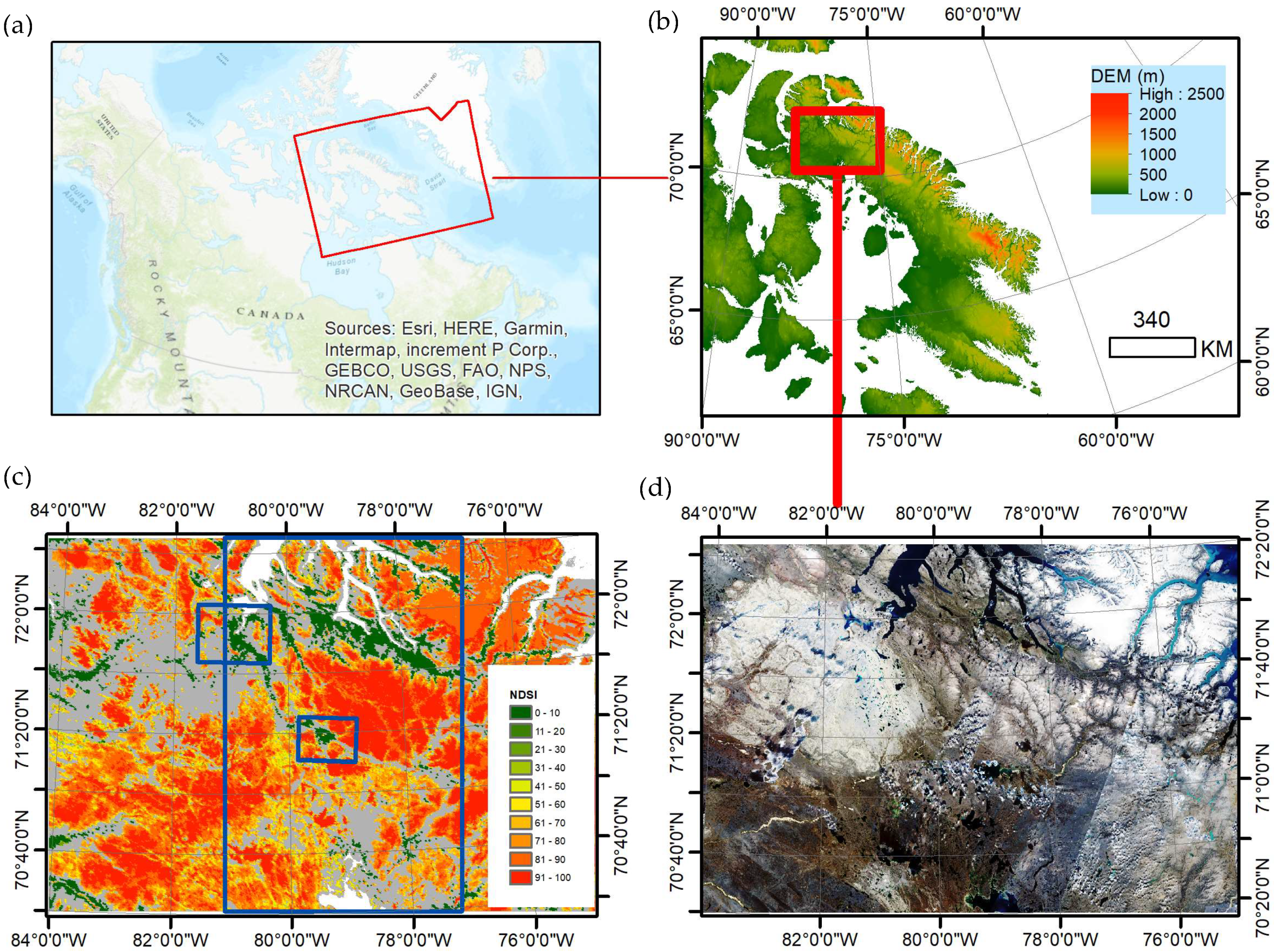
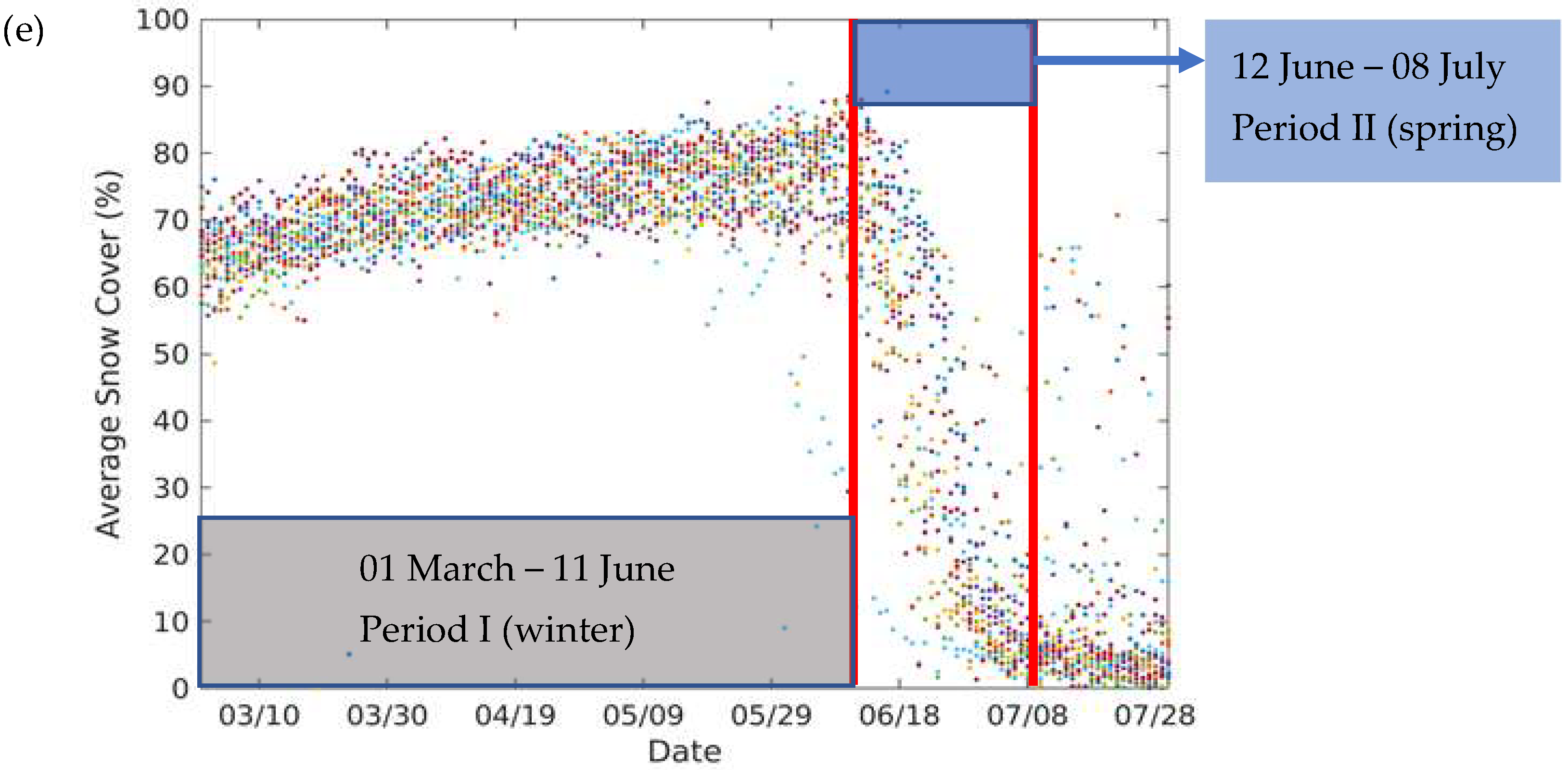


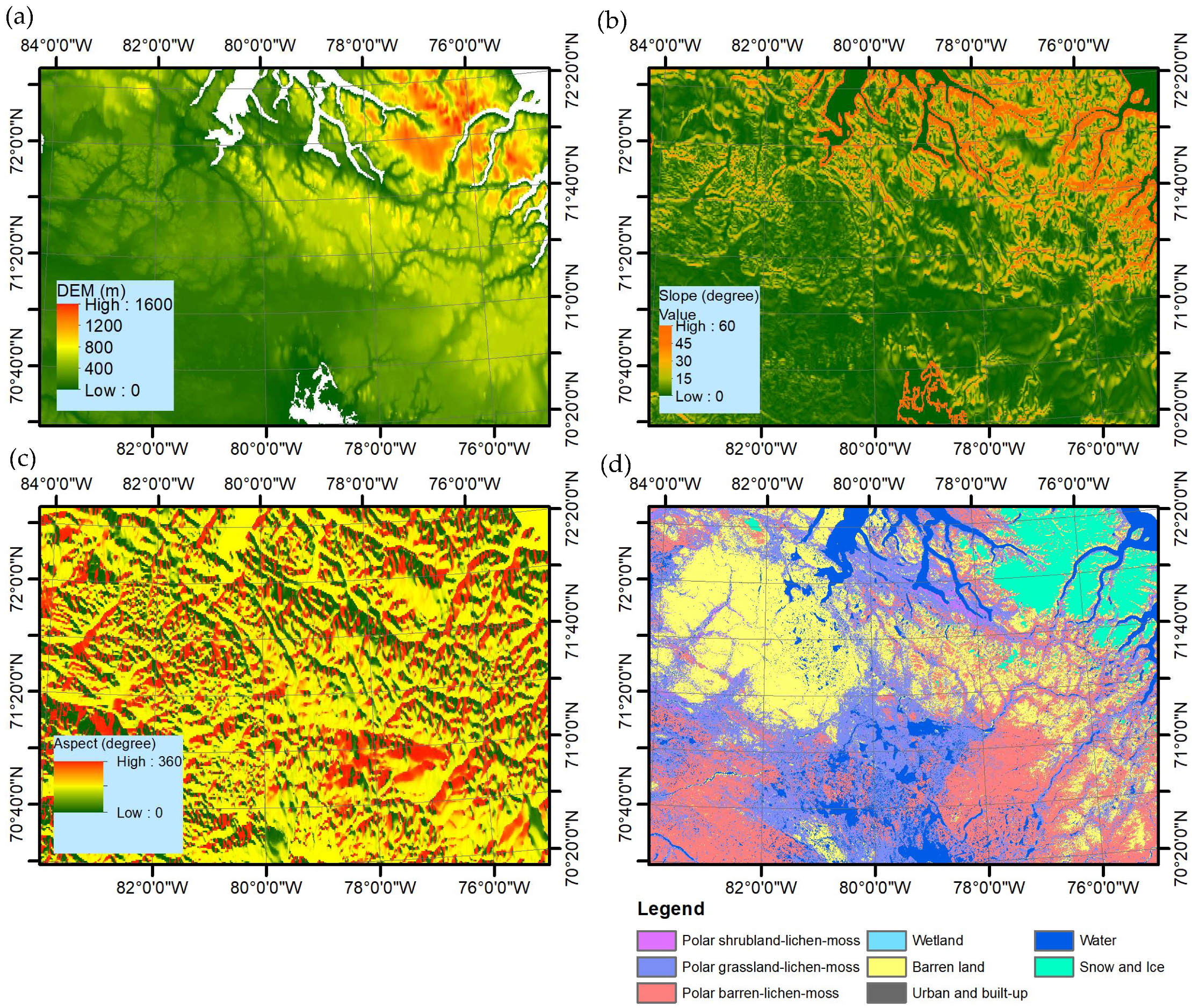
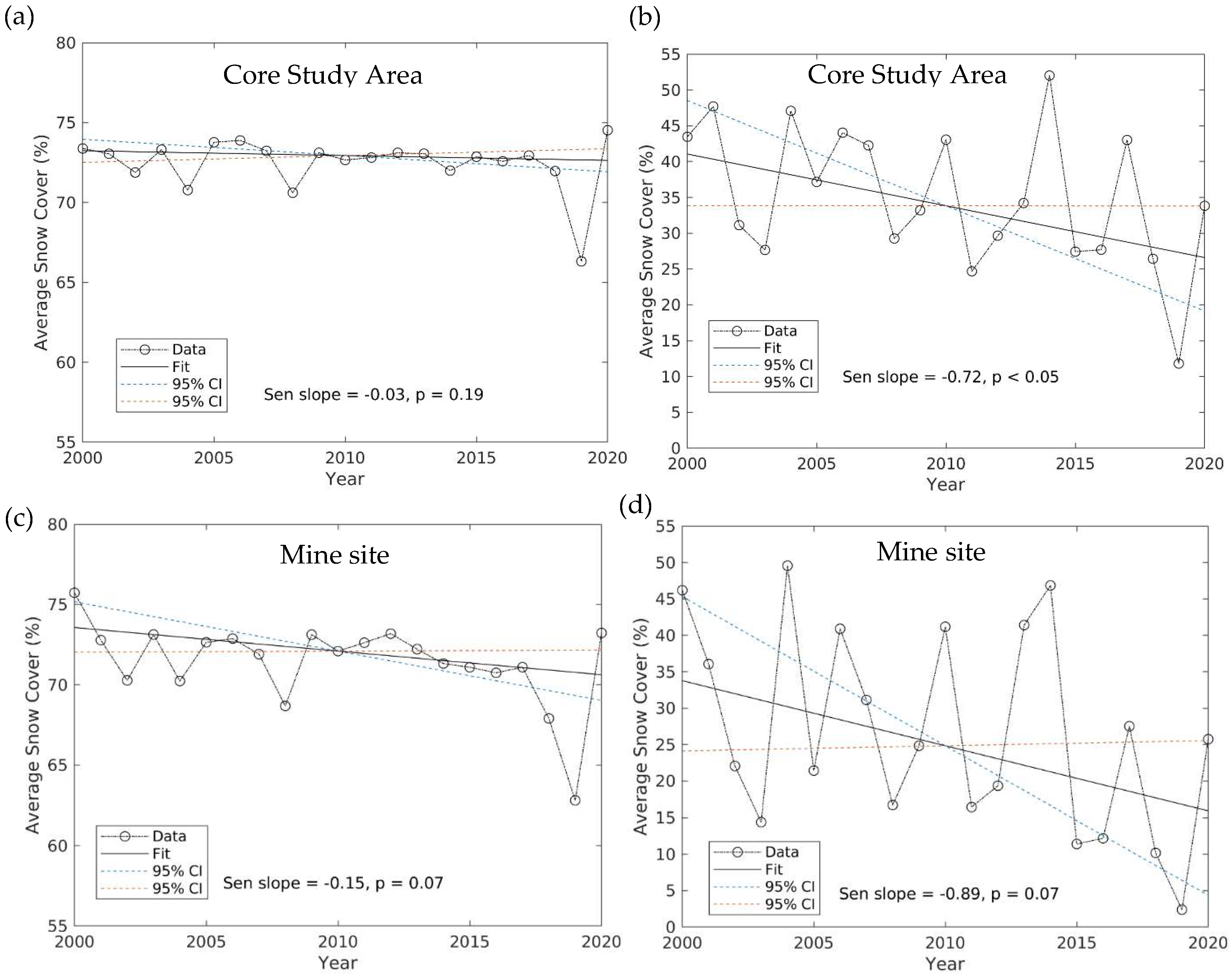
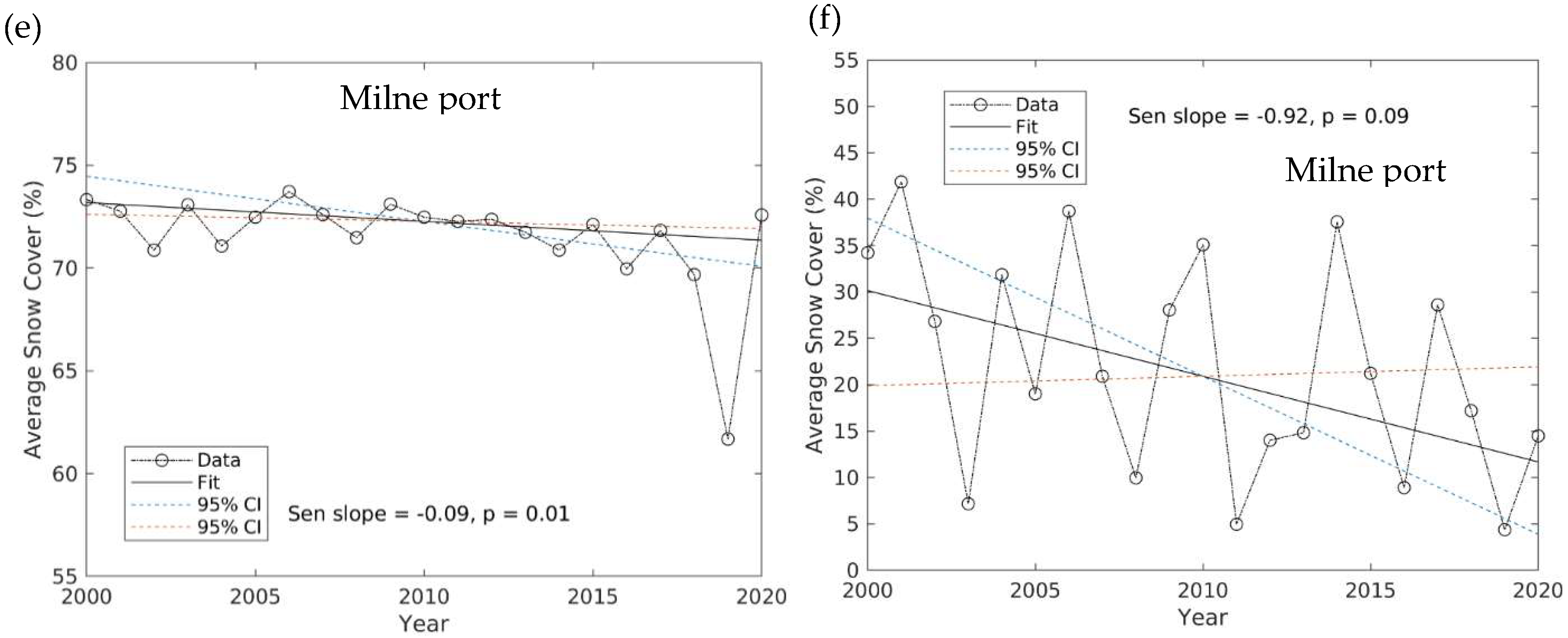
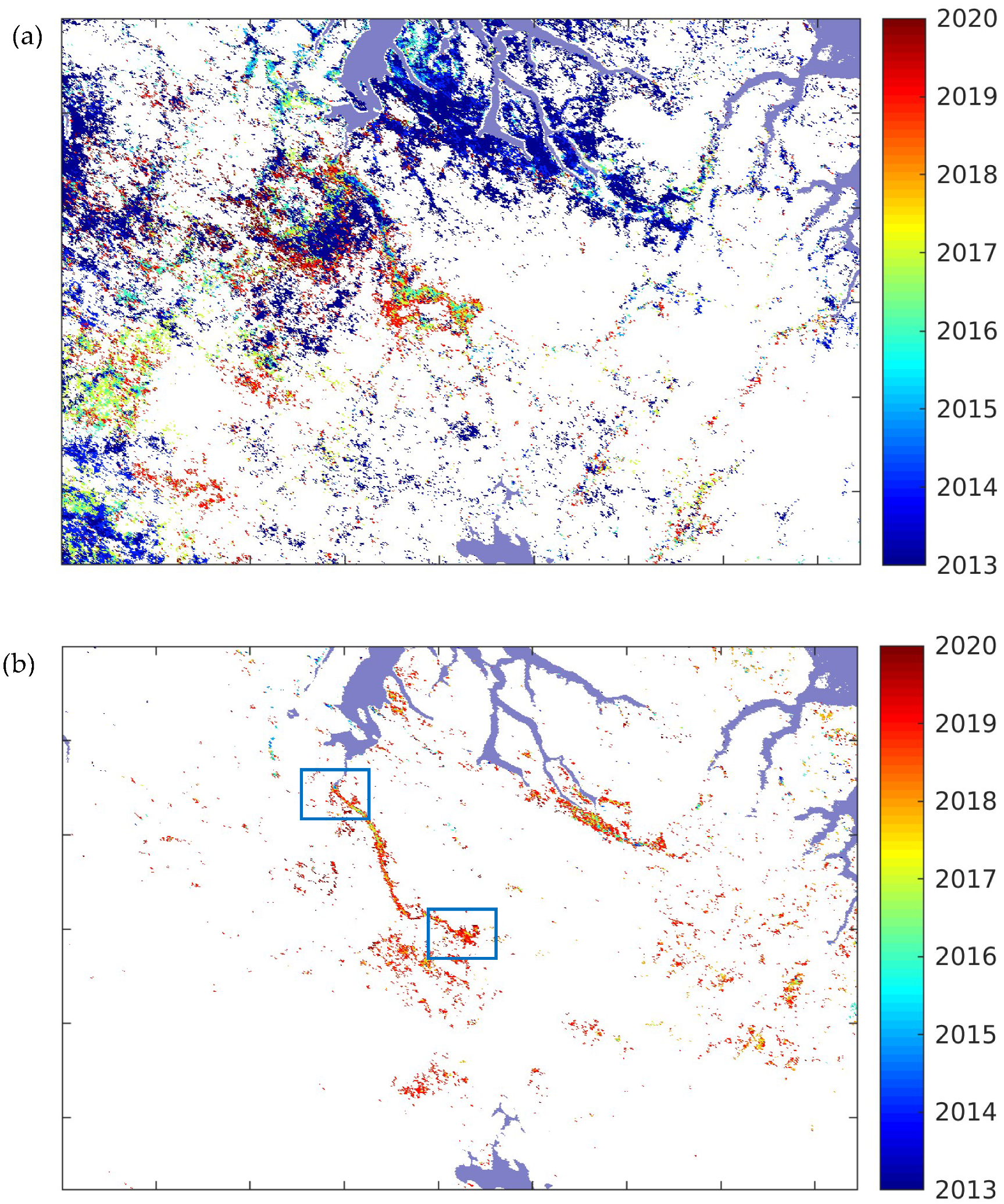
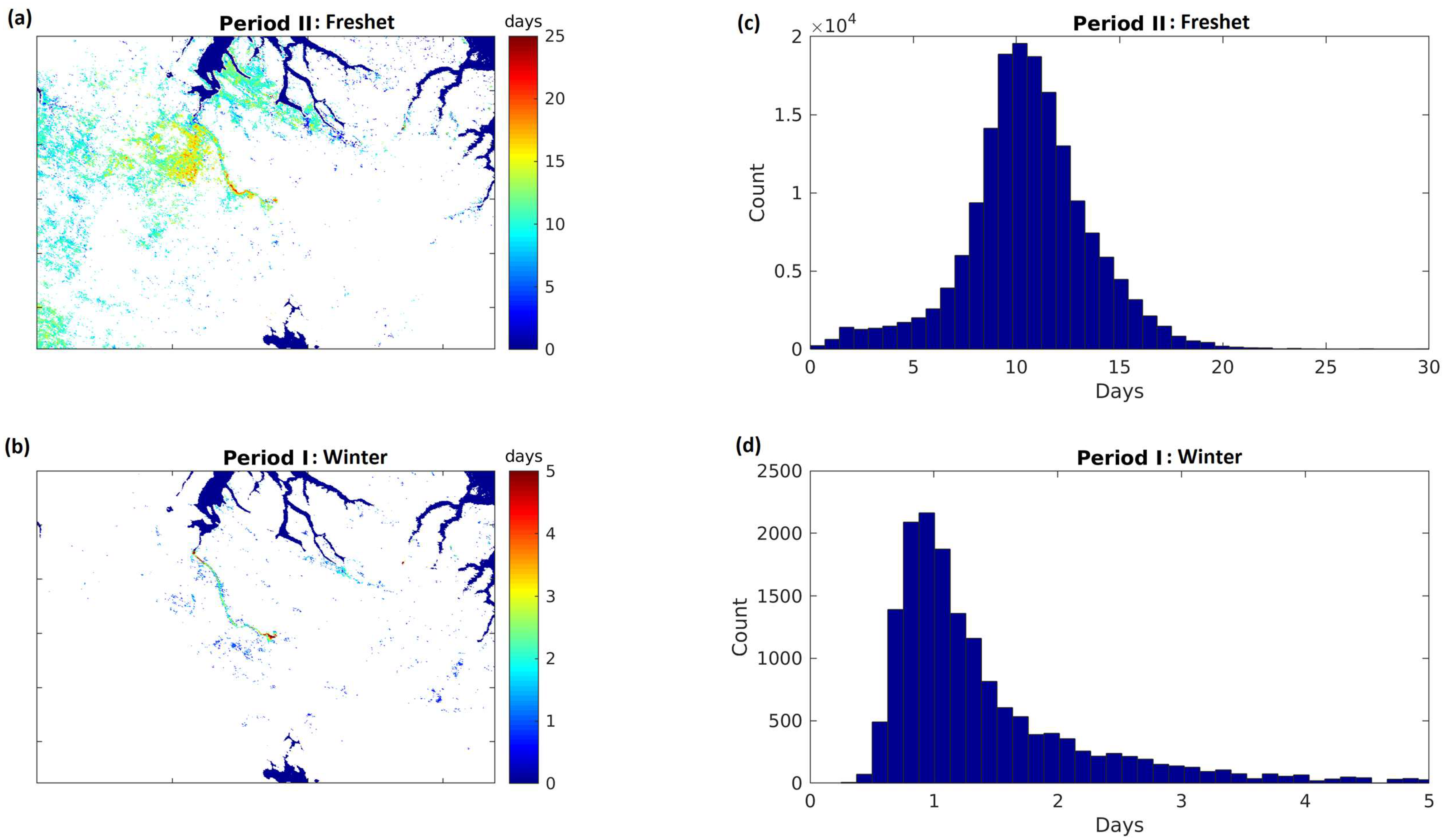
Disclaimer/Publisher’s Note: The statements, opinions and data contained in all publications are solely those of the individual author(s) and contributor(s) and not of MDPI and/or the editor(s). MDPI and/or the editor(s) disclaim responsibility for any injury to people or property resulting from any ideas, methods, instructions or products referred to in the content. |
© 2023 by the authors. Licensee MDPI, Basel, Switzerland. This article is an open access article distributed under the terms and conditions of the Creative Commons Attribution (CC BY) license (https://creativecommons.org/licenses/by/4.0/).
Share and Cite
He, L.; White, H.P.; Chen, W. Compounded Impacts of Global Warming and Anthropogenic Disturbances on Snowmelt in Northern Baffin Island. Remote Sens. 2023, 15, 313. https://doi.org/10.3390/rs15020313
He L, White HP, Chen W. Compounded Impacts of Global Warming and Anthropogenic Disturbances on Snowmelt in Northern Baffin Island. Remote Sensing. 2023; 15(2):313. https://doi.org/10.3390/rs15020313
Chicago/Turabian StyleHe, Liming, H. Peter White, and Wenjun Chen. 2023. "Compounded Impacts of Global Warming and Anthropogenic Disturbances on Snowmelt in Northern Baffin Island" Remote Sensing 15, no. 2: 313. https://doi.org/10.3390/rs15020313
APA StyleHe, L., White, H. P., & Chen, W. (2023). Compounded Impacts of Global Warming and Anthropogenic Disturbances on Snowmelt in Northern Baffin Island. Remote Sensing, 15(2), 313. https://doi.org/10.3390/rs15020313





